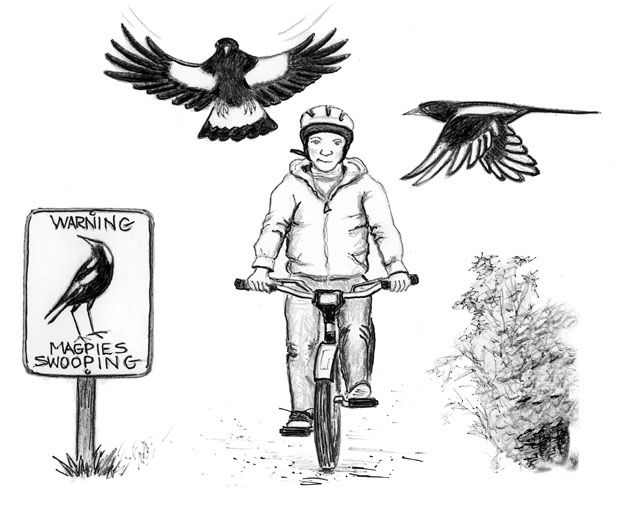
Dear Bird Folks,
I’m making plans to visit a friend of mine in Australia. She sent me a letter saying that I could come anytime but suggested that I avoid September because that’s’ “swooping season” for their birds. I know Australians have different expressions than we have, but what is swooping season?
– Barbara, Reading, PA
You are so right, Barb,
Australians do have unique ways of speaking. I too have friends from Down Under and anytime they call me, I have to hire an interpreter from the UN to figure out what the heck they are talking about. For example, “tucker” is food, “strides” are pants and “chooks” are chickens. Don’t ask me how they came up with these odd expressions, but I’d be willing to bet that many of their peculiar words originated after a night of too many “tallies” (large bottles of beer). I’ve written about Australia before and I think at the time I remarked that I loved going there because just about anything and everything can kill you. They have dingoes, crocs, sharks, poisonous snakes, deadly plants (yes, plants) and the most dangerous creatures of them all, Aussie drivers. You can also put deadly birds on that list. The aggressive birds in this case are the Australian Magpies. Calling them “deadly” may be a bit of a stretch, but the birds can be very aggressive and a few people have had serious accidents in an effort to avoid their attacks. Better pay up on your life insurance before you go, Barb.
The Australian Magpie looks like a black and white American Crow, and just like our crows the magpie has adapted very well to human expansion. They live in parks, neighborhoods and on farms. They thrive throughout much of Australia and can be found as far north as New Guinea. (Whoa! New Guinea! You just know it’s a tough bird if it can live in New Guinea.) Because Australia is upside-down, its seasons are the opposite of ours. In September, when we start thinking about fall, they are getting ready for spring. And when our birds are beginning to migrate, many of their birds are starting to build nests. It is during the breeding season that the swooping and all of the craziness takes place.
When magpies are nesting they are extremely aggressive. They will “swoop” down and peck anything they perceive to be a predator. They’ll go after hawks, cats, dogs, kangaroos and people. But what the birds really hate are people on bikes. (Oddly, kangaroos on bikes are often left alone.) For some reason they’ll go out of their way to attack anyone riding a bike, even if the biker is hundreds of feet away from the nest. Bike helmets do little good because the birds are skilled at avoiding the helmet and will go for anything that’s exposed. Nobody knows why they attack cyclists like they do, but it’s assumed that the birds are simply annoyed by those goofy outfits bikers wear, and who can blame them?
Swooping season in Australia is real and not some urban myth put forth to keep ornithophobics from visiting the country. The Internet is full of info telling people how they can protect themselves and signs are posted in parks warning everyone to be on guard. Many Aussie bike shops sell special helmets designed to ward off the birds. The City of Brisbane’s (“Brizzie” to them) website actually has an interactive map showing folks areas to avoid. In the U.S., we get traffic reports; Down Under gets magpie reports. Now that’s a cool country.
You’d think that the locals would hate a bird that causes them so much trouble, but apparently that is not always the case. Magpies form close family groups, are non-migratory and live in the same territory year-round. Some of them may live as long as twenty-five or thirty years. That means the same magpies could reside in the same neighborhood for decades. In some cases, humans actually get to know individual birds and the birds learn to identify and trust certain humans. And because Australia is a warm weather country, their doors are often left open. Magpies have been known to wander into a house, help themselves to a snack and no one seems to mind. Magpies are like maintenance-free pets. There are no litter boxes to clean, no rabies shots to get, no walking on rainy nights and no vet bills to pay. Australian Magpies are nearly perfect companions, if you don’t mind the few weeks each year when they try to peck your eyes out.
Even though swooping season is an annoyance, Barbara, don’t let it keep you from visiting your friend. Australia is a wonderful country and it has the best birds. If you go, be sure to visit my friends. They live near the town of Woolloongabba (I’m not kidding). I don’t know who came up with that wacky name, but you can bet there were a lot of “tallies” involved.
On a different topic:
Last week’s warm weather has brought the hummingbirds back to New England early this year. It’s already time to put out your feeders. If you make your own hummingbird food (and you should), the recipe is four parts water to one part sugar. Say, that’s the first time in 2010 I’ve had to recite that recipe. One down, forty-two gazillion more times to go.